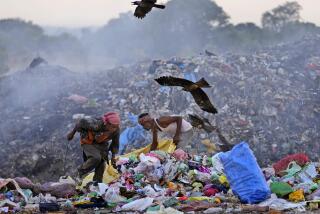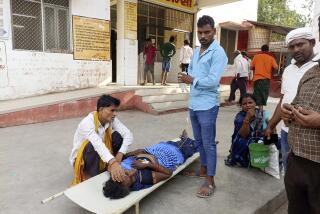Northern India, Land of ‘Heat and Dust,’ Bundles Up in an Unusually Cold Winter
- Share via
NEW DELHI — The shoeshine boy waited like a hawk, his eyes fixed on a large family eating lunch on paper plates in a park.
Jagdish Rajkumar, a scrawny teen-ager, was not interested in the food.
The moment the family finished the food and threw away the paper plates, Rajkumar darted over and tucked the plates into a bag and resumed his business, calling out “Get your shoes polished for two rupees (13 cents).”
Rajkumar is one the millions of poor people across northern India who are collecting rags, scraps of paper, bits of straw and anything else that burns in an effort to keep warm during an unusually cold Indian winter.
Especially prized is cow dung, which makes excellent fuel when dried and patted into cakes.
In recent days, 24 people in northern India have died because of the cold, according to official reports. Newspapers put the death toll at 100.
This winter is mild by international standards but exceptionally chilly in a region better known for its torrid summer heat.
“It is cold if you take into consideration a lesser-discussed meteorological phenomenon,” said G. S. Mondal of the New Delhi’s Weather Office. He explained that a temperature of 42 degrees Fahrenheit, combined with a 19-m.p.h. wind, made it feel like it was just above freezing, and that has “a tremendous biological impact on us.”
New Delhi’s normal winter temperatures range from 46 to 50, but even a few degrees make a big difference to people with little or no shelter.
“In between my business I collect as much paper as I can to keep us warm at night,” said Rajkumar, who earns about $1 a day. He said he gives about 33 cents to police so they’ll look the other way when he scavenges for paper in the park at Connaught Place, New Delhi’s central shopping district.
“I have old parents and three sisters at home. We all sleep in one room with a fire or we will freeze to death,” he said.
Wood is too expensive for many.
About two pounds of wood costs 7 cents, and it lasts only for minutes, “so what we do is pick up everything and anything that burns” the shoeshine boy said.
Even tourists from other climates are finding the India of “Heat and Dust,” the book and screenplay by Ruth Prawer Jhabwala, has turned cold.
Richard and Mary Thomson of Mill Valley, Calif., said they dreamed of the “golden rays of tropical Indian sun” when they planned their vacation in the subcontinent.
“We never thought we would be using this in India,” Thomson said, pointing at his sweater, his first purchase in an Indian bazaar.
“I had expected India to be much warmer. It is cold, but I am enjoying it,” said Eric Eubank, 19, of Frederick, Md., a philosophy student at St. Andrews Presbyterian College in Laurinburg, N.C. “When you think of India, you think of the heat and not cold.”
“In our country it is cold, too, but there we have centrally heated homes and offices. Here there is none,” said Nanna Rosenstock of Copenhagen. “We manage here, but we wonder what the poor among the Indians do.”
Hundreds of people succumb to cold weather in India every year because they do not have adequate clothing, shelter and food. Some of those fortunate enough to have homes die of carbon monoxide from unventilated fires.
Beggars, migrant laborers and other poorest of the poor are the hardest hit because they have no shelter. They normally sleep in parks, on sidewalks or under bridges.
As nightfall approaches, some head to railway stations and government-run shelters. Others bribe guards at government buildings to let them to spend the night in the corridors.
More to Read
Sign up for Essential California
The most important California stories and recommendations in your inbox every morning.
You may occasionally receive promotional content from the Los Angeles Times.













